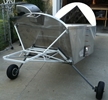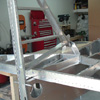


random user submitted photo
Wing skin corrosion
11 posts
• Page 1 of 2 • 1, 2
Wing skin corrosion
Today I took the wings out of the garage for the first time in a year and have noticed that one small part where it was leaning against an piece of steel has corroded all the way through. The location is the rib number 5 on the lower left wing skin.

Can anyone suggest to me a fix for this or would it be better to replace the lower skin?
Thanks
Craig

Can anyone suggest to me a fix for this or would it be better to replace the lower skin?
Thanks
Craig
Last edited by ccm on Sun Dec 14, 2014 3:45 pm, edited 1 time in total.
Craig Miller
Sonex 1526
Standard gear, AeroVee
http://kdmiller.unospace.net/mediawiki/index.php?title=Main_Page
Sonex 1526
Standard gear, AeroVee
http://kdmiller.unospace.net/mediawiki/index.php?title=Main_Page
- ccm
- Posts: 24
- Joined: Mon Apr 30, 2012 6:22 pm
- Location: West Sussex, England, UK
Re: Wing skin corrosion
Page 4-32 of AC43.13 covers repairs of stressed wing skins.
http://www.faa.gov/documentLibrary/medi ... ter_04.pdf
There is another chapter on corrosion. You could ask Sonex too. I would patch unless you couldn't stand the aesthetics. Is it on the top or bottom? Any other issues that need to be addressed? Bummer that you ended up with that hole.
A nickel and dime patch would work too. Drill out the hole to make it round, have a circle of metal that just fits, another circle that is bigger. Rivet the two circles together in the middle and rivet the big circle underneath. Looks like the rib may interfere though.
http://www.faa.gov/documentLibrary/medi ... ter_04.pdf
There is another chapter on corrosion. You could ask Sonex too. I would patch unless you couldn't stand the aesthetics. Is it on the top or bottom? Any other issues that need to be addressed? Bummer that you ended up with that hole.
A nickel and dime patch would work too. Drill out the hole to make it round, have a circle of metal that just fits, another circle that is bigger. Rivet the two circles together in the middle and rivet the big circle underneath. Looks like the rib may interfere though.
Bryan Cotton
Poplar Grove, IL C77
Waiex 191 N191YX
Taildragger, Aerovee, acro ailerons
dual sticks with sport trainer controls
Prebuilt spars and machined angle kit
Year 2 flying and approaching 200 hours December 23
Poplar Grove, IL C77
Waiex 191 N191YX
Taildragger, Aerovee, acro ailerons
dual sticks with sport trainer controls
Prebuilt spars and machined angle kit
Year 2 flying and approaching 200 hours December 23
-

Bryan Cotton - Posts: 5497
- Joined: Mon Jul 01, 2013 9:54 pm
- Location: C77
Re: Wing skin corrosion
Thanks Bryan. We've now drilled it to 3/8 which was required to get rid of all the corroded material. It's in the bottom skin so a patch like you said sounds like a good idea.
It's annoying because it is just about time to move to the airfield so this will delay it.
Craig
It's annoying because it is just about time to move to the airfield so this will delay it.
Craig
Craig Miller
Sonex 1526
Standard gear, AeroVee
http://kdmiller.unospace.net/mediawiki/index.php?title=Main_Page
Sonex 1526
Standard gear, AeroVee
http://kdmiller.unospace.net/mediawiki/index.php?title=Main_Page
- ccm
- Posts: 24
- Joined: Mon Apr 30, 2012 6:22 pm
- Location: West Sussex, England, UK
Re: Wing skin corrosion
I am amazed at how bad that corrosion is after just 1 year. Is that corrosion under the rivets as well? The picture makes it look like it is, especially the top one in the picture. Maybe I should rethink my corrosion protection plan, or lack thereof.
- Direct C51
- Posts: 178
- Joined: Wed Jul 09, 2014 8:32 pm
Re: Wing skin corrosion
The stuff under the rivets is duralac which is an anti-corrosion compound. The corrosion is basically localised to that one hole in the metal and is the result of sitting on some rusty steel.
Craig Miller
Sonex 1526
Standard gear, AeroVee
http://kdmiller.unospace.net/mediawiki/index.php?title=Main_Page
Sonex 1526
Standard gear, AeroVee
http://kdmiller.unospace.net/mediawiki/index.php?title=Main_Page
- ccm
- Posts: 24
- Joined: Mon Apr 30, 2012 6:22 pm
- Location: West Sussex, England, UK
Re: Wing skin corrosion
Direct C51 wrote:I am amazed at how bad that corrosion is after just 1 year. Is that corrosion under the rivets as well? The picture makes it look like it is, especially the top one in the picture. Maybe I should rethink my corrosion protection plan, or lack thereof.
Look up galvanic corrosion. Happens when you have 2 dissimilar metals in contact with each other.
Michael
Sonex #145 from scratch (mostly)
Taildragger, 2.4L VW engine, AeroInjector, Prince 54x48 P-Tip
VH-MND, CofA issued 2nd of November 2015
First flight 7th of November 2015
Phase I Completed, 11th of February 2016
http://www.mykitlog.com/rizzz/
Sonex #145 from scratch (mostly)
Taildragger, 2.4L VW engine, AeroInjector, Prince 54x48 P-Tip
VH-MND, CofA issued 2nd of November 2015
First flight 7th of November 2015
Phase I Completed, 11th of February 2016
http://www.mykitlog.com/rizzz/
- rizzz
- Posts: 869
- Joined: Tue Jun 21, 2011 2:07 am
- Location: Wollongong, NSW, Australia
Re: Wing skin corrosion
rizzz wrote:Look up galvanic corrosion. Happens when you have 2 dissimilar metals in contact with each other.
Yeah, I'm familiar with galvanic corrosion. My surprise is in how fast so much damage was done.
Can someone explain how the wing skin corroded so fast next to steel, but the stainless steel rivets don't have a similar effect. It is my understanding that stainless steel has a bigger difference in nobility with aluminum than steel does with aluminum.
- Direct C51
- Posts: 178
- Joined: Wed Jul 09, 2014 8:32 pm
Re: Wing skin corrosion
This is going to be something short of an explanation, but when I started building my Sonex, a friend mentioned the problem of galvanic corrosion of aluminium yacht masts in contact with stainless steel fittings, so I had a chat to a metallurgist. His advice was that corrosion wouldn't be a problem if oxygen was excluded from the joint by using a sealant such as Duralac - no oxygen-no oxide. That doesn't quite explain why all the builders who don't seal their rivets don't usually have corrosion problems, but it probably comes down to things like the aircraft not being stored in salty sea air or that the joint is tight enough so that not much oxygen can get at the area where the dissimilar metals contact. He also said the the problem was more complicated than just the order on the galvanic table, but chemistry is not my strong suit so I didn't push him on that. Looks like you fixed part of the problem with the duralac on the rivets, but obviously there was no shortage of oxygen where the wing touched the bit of steel.
Peter Anson
Sonex 894
Peter Anson
Sonex 894
- peter anson
- Posts: 558
- Joined: Thu Jul 31, 2014 2:34 am
- Location: Mount Macedon, Australia
Re: Wing skin corrosion
Corrosion of dissimilar metals requires three things. Two different chemistry metals and an electrolyte (water). The more noble material, aluminum, is the anode and the less noble, stainless rivets (which contain some iron), the cathode. The difference in potential sets up a very weak current from the anode to the cathode which carries some of the anode with it. The potential between aluminum and stainless steel is very low due to the high amount of alloy, and low per cent of iron, in the stainless.
In your case you said the steel was rusty. Rust is 100% iron oxide, FE3O4, and is caused by the oxygen in water combining with the iron in the steel. So you had all the worst conditions present. Iron oxide, with a high concentration of iron and oxygen, and a high potential, and water to make the circuit complete. The potential between the stainless rivets and 6063 is not high enough to be concerned about, unless you live next to the ocean, then you should consider painting. Salt water is a better electrolyte.
Onex 107
In your case you said the steel was rusty. Rust is 100% iron oxide, FE3O4, and is caused by the oxygen in water combining with the iron in the steel. So you had all the worst conditions present. Iron oxide, with a high concentration of iron and oxygen, and a high potential, and water to make the circuit complete. The potential between the stainless rivets and 6063 is not high enough to be concerned about, unless you live next to the ocean, then you should consider painting. Salt water is a better electrolyte.
Onex 107
OneX 107
N2107X
N2107X
- Onex107
- Posts: 506
- Joined: Mon Mar 24, 2014 6:44 pm
- Location: Peoria, IL
Re: Wing skin corrosion
Onex wrote:Corrosion of dissimilar metals requires three things. Two different chemistry metals and an electrolyte (water). The more noble material, aluminum, is the anode and the less noble, stainless rivets (which contain some iron), the cathode. The difference in potential sets up a very weak current from the anode to the cathode which carries some of the anode with it. The potential between aluminum and stainless steel is very low due to the high amount of alloy, and low per cent of iron, in the stainless.
In your case you said the steel was rusty. Rust is 100% iron oxide, FE3O4, and is caused by the oxygen in water combining with the iron in the steel. So you had all the worst conditions present. Iron oxide, with a high concentration of iron and oxygen, and a high potential, and water to make the circuit complete. The potential between the stainless rivets and 6063 is not high enough to be concerned about, unless you live next to the ocean, then you should consider painting. Salt water is a better electrolyte.
Onex 107
Very enlightening, thank you!
Michael
Sonex #145 from scratch (mostly)
Taildragger, 2.4L VW engine, AeroInjector, Prince 54x48 P-Tip
VH-MND, CofA issued 2nd of November 2015
First flight 7th of November 2015
Phase I Completed, 11th of February 2016
http://www.mykitlog.com/rizzz/
Sonex #145 from scratch (mostly)
Taildragger, 2.4L VW engine, AeroInjector, Prince 54x48 P-Tip
VH-MND, CofA issued 2nd of November 2015
First flight 7th of November 2015
Phase I Completed, 11th of February 2016
http://www.mykitlog.com/rizzz/
- rizzz
- Posts: 869
- Joined: Tue Jun 21, 2011 2:07 am
- Location: Wollongong, NSW, Australia
11 posts
• Page 1 of 2 • 1, 2
Who is online
Users browsing this forum: No registered users and 0 guests







